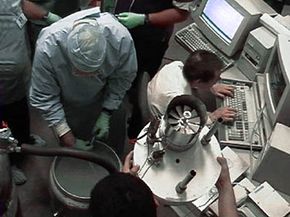What Is Cryonics?
Cryonics is the practice of preserving human bodies in extremely cold temperatures with the hope of reviving them sometime in the future. The idea is that, if someone has "died" from a disease that is incurable today, he or she can be "frozen" and then revived in the future when a cure has been discovered. A person preserved this way is said to be in cryonic suspension.
To understand the technology behind cryonics, think about the news stories you've heard of people who have fallen into an icy lake and have been submerged for up to an hour in the frigid water before being rescued. The ones who survived did so because the icy water put their body into a sort of suspended animation, slowing down their metabolism and brain function to the point where they needed almost no oxygen.
Advertisement
Cryonics is a bit different from being resuscitated after falling into an icy lake, though. First of all, it's illegal to perform cryonic suspension on someone who is still alive. People who undergo this procedure must first be pronounced legally dead -- that is, their heart must have stopped beating. But if they're dead, how can they ever be revived? According to scientists who perform cryonics, "legally dead" is not the same as "totally dead." Total death, they say, is the point at which all brain function ceases. Legal death occurs when the heart has stopped beating, but some cellular brain function remains. Cryonics preserves the little cell function that remains so that, theoretically, the person can be resuscitated in the future.
